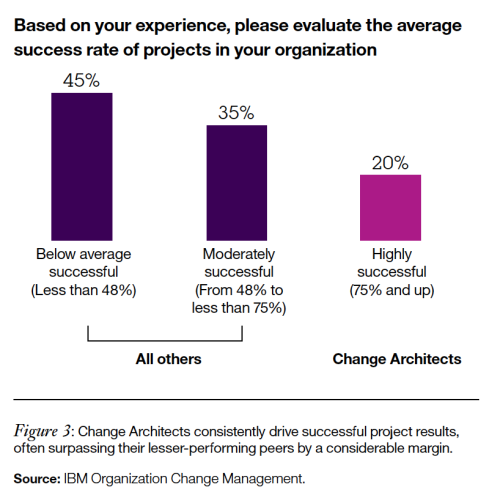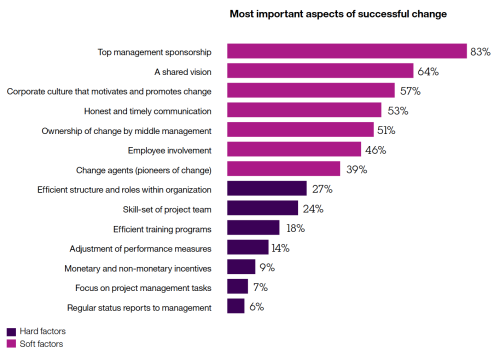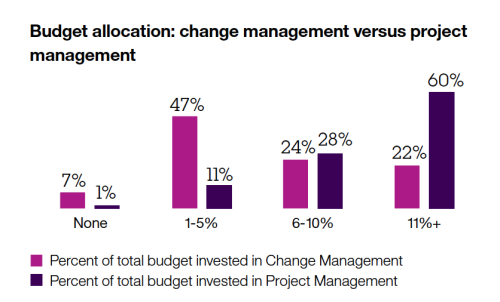
IBM recently released an executive report: “Making change work… while the work keeps changing – How change architects lead and manage organizational change.” The report, based on data from their latest “Making Change Work Study” seems a very pertinent one for the times. As a whole, we know that this is a period of significant change for the workforce, we talk about these changes, and how they can and are affecting organizations, but there is significantly less talk around how organizations are successfully managing such change – which is exactly what IBM’s report dives into. As IBM states, “the gap between the magnitude of change and the ability of organizations to manage it continues to widen.” While many organizations are struggling to close this gap, IBM identifies a select few – change architects – that have “found the keys to making change work while the work keeps changing.” IBM’s data is based on survey results from almost 1,400 individuals responsible for designing, creating or implementing change across their respective organizations.
In IBM’s study, they consider only the top 20 percent of organizations to be highly successful when it comes to change management. These “Change Architects” are organizations that indicated at least 75% of their projects were a complete success (i.e. a minimum of three-in-four projects met all predefined goals).
Change Architects capitalize on “the vortex of change permeating every aspect of business.” Such organizations are considerably more successful at managing projects. Compared to the average in IBM’s survey, Change Architects have at least 56 percent more projects that were a complete success. What do Change Architects do differently to manage change in their organizations? IBM identifies three critical imperatives that allow them to be change-effective:
- “Lead at all Levels”
- “Make Change Matter”
- “Build the Muscle”
When it comes to managing change, organizations must lead at all levels. Many organizations fail to successfully manage change because they have do not embrace a “change-centric” culture, despite, as IBM points out, that change is the one constant that organizations will always face. Driving a change-centric culture must begin at the top from executive management and cascade throughout all levels of the organization. Survey respondents view “Top Management Sponsorship for Change” as the #1 most important aspect for organizational change:

Despite this fact, only 66% of respondents state that their top management is enabled to act as change leaders (for Change Architects, this jumps to 77%). How are top management at Change Architect organizations driving change? IBM identifies three key characteristics that enable leaders to drive change across the organization:
- Role modeling throughout the organization.
- Engaging employees with a compelling case for change.
- Empowering new and passionate change leaders at all organizational levels.
Another critical responsibility of top management in regards to effectively managing change is making change matter. Managers must make sure that if change management programs exist, employees thoroughly understand the activities and benefits of those programs. The majority of organizations invest only 5% or less of total project budgets in change management activities on key projects, and 87 percent of respondents indicate that not enough focus is currently placed on change management in critical projects.
Respondents report that when change management activities are incorporated into the overall project plans from the beginning, successful project results are more likely. What then, is preventing change management activities? According to survey respondents, there are five key barriers that keep organizations from pursuing new change capabilities:
- Change management benefits are not clear (69%)
- Change management activities are not clear (53%)
- Role of change professional is not clear (49%)
- Lack of skilled change management resources (43%)
- Change management is too expensive (26%)
Last but not least, Change Architect organizations – those that are successful at managing change – have a focus on “building muscle.” 60% of organizations in IBM’s study confirm a formal career path for project managers. This is opposed to only 25% for change professionals. Change Architects often establish a formal career path for change professionals (42% more than other organizations). They use this formalized change discipline for central change coordination; to drive consistent methods, change-related trainings, career developments, asset reuse, company-wide knowledge and best practice sharing.

While organizations that we can truly call “Change Architects” may still be few are far between, the good news is that between 2008 and 2014 the use of formal change management methods increased significantly. This indicates that awareness for this organizational management need is, at the very least, rising on companies’ radars. Managing change is tough, as we all know. This report suggests that making change management a core competence in our organizations may just make our change experiences more successful in every way. Building and exercising change management muscles may make all the difference!








